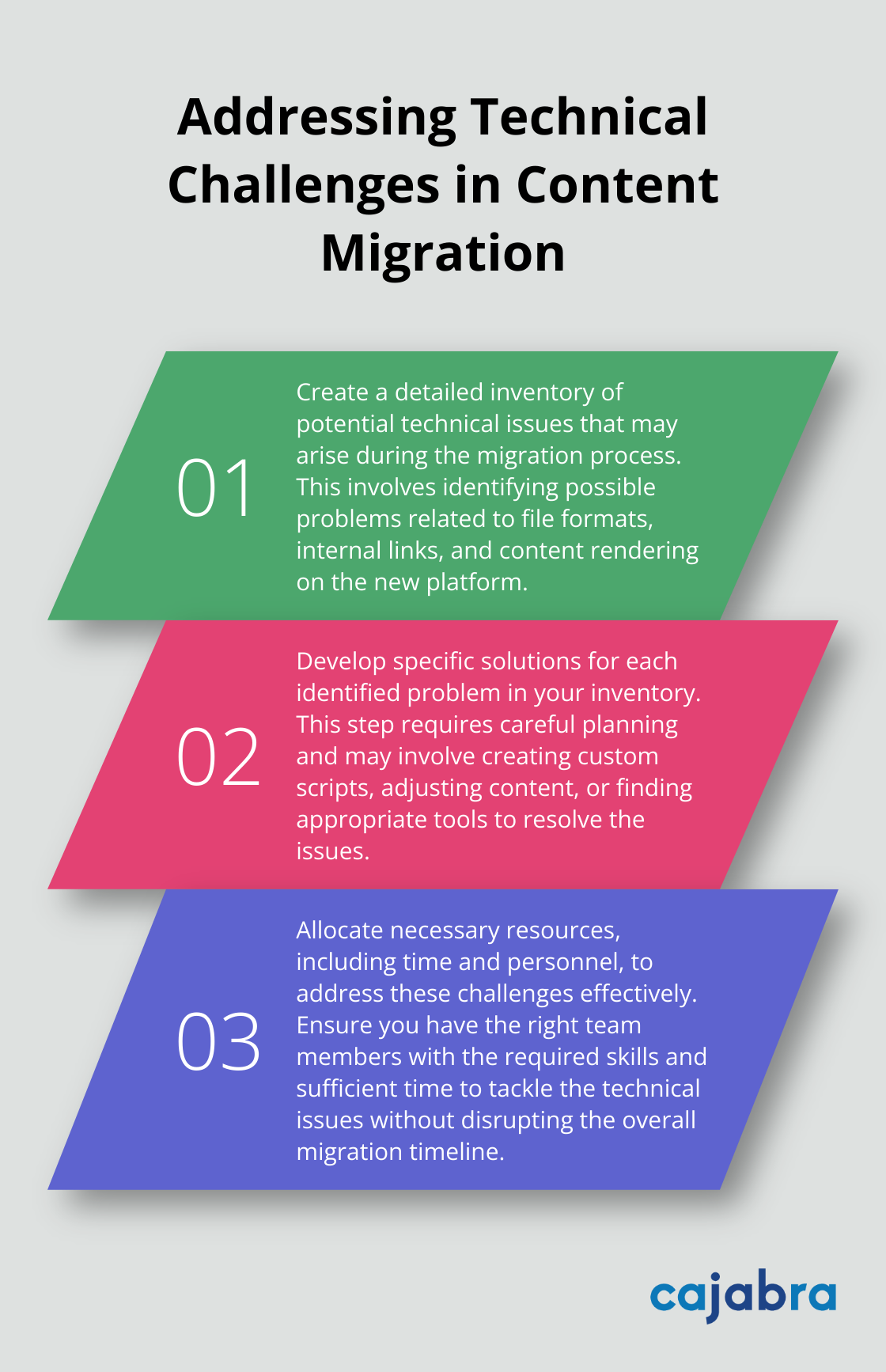
Content migration can be a daunting task for businesses of all sizes. At Cajabra, LLC, we've seen firsthand how a well-executed content migration plan can transform digital presence and user experience.
This blog post will guide you through creating an effective content migration plan, from assessing your current content to executing the migration process. We'll provide practical steps and insights to help you navigate this complex but essential journey.
Start by cataloging all your existing content. This includes web pages, blog posts, images, videos, PDFs, and any other digital assets. Use web crawling tools to ensure you don't miss hidden or forgotten content. A Comprehensive Content Inventory typically involves three steps: asset audit, cleaning up and defining your metadata structure, and figuring out how to organize your assets.

After you compile your inventory, assess the performance of each piece. Look at metrics like page views, time on page, and conversion rates. Tools like Google Analytics can provide valuable insights. Identify your top-performing content as well as underperforming assets that might need improvement or removal.
Set specific, measurable goals for your content migration. Do you aim to improve user experience? Boost SEO rankings? Increase content accessibility? Make sure your objectives align with your overall business strategy. Ensuring your content is written to be accessible to your audience is an important consideration when migrating content to a new website.
Understanding your audience is key to effective content migration. Create user personas and map your content to different stages of the customer journey. This exercise will help you identify gaps in your content and prioritize what needs migration, updates, or creation from scratch.
Consider where your content will live post-migration. Are you moving to a new CMS? Adopting a headless architecture? Each platform has its strengths and limitations. For instance, a headless CMS offers greater flexibility and scalability (which can be particularly beneficial for businesses with complex content needs).
A thorough assessment sets the stage for a smooth migration process. The next step involves developing a robust content migration strategy, which we'll explore in detail in the following section.
The choice of migration tools can determine the success of your project. Look for tools that support your specific content types and offer features like content mapping, automated transfers, and error reporting. Popular options include the WordPress Importer for blog migrations or Drupal's Migrate API for more complex scenarios. A combination of automated and manual processes often produces the best results.
Content mapping forms the foundation of your migration strategy. Create a detailed spreadsheet that outlines how each piece of content will transition from the old system to the new one. Include information such as current URLs, new URLs, content types, and any necessary transformations. This map will serve as your blueprint throughout the migration process.
Quality assurance is essential in content migration. Establish a multi-step review process that includes automated checks and manual reviews. Use tools to crawl your migrated content and identify broken links or missing meta data. Set up a staging environment where you can thoroughly test the migrated content before going live. A study by Bloor Research found that over 80% of data migration projects overran or were aborted, emphasizing the importance of robust quality control.

Redirects play a critical role in maintaining SEO value and user experience. Create a comprehensive redirect plan that maps old URLs to new ones. Use 301 redirects for permanent moves and ensure that every old page has a corresponding new destination. Tools like Redirection for WordPress can simplify this process.
Content transformation is often necessary during migration. This process involves adapting your content to fit the new platform's structure and requirements. It may include reformatting text, resizing images, or restructuring metadata. Plan for these transformations in advance to streamline the migration process and ensure your content displays correctly on the new platform.
With a solid strategy in place, you're ready to move on to the execution phase. The next section will guide you through the actual process of migrating your content, including preparation, implementation, and post-migration checks.
Before you start the migration, clean and organize your content. Remove outdated materials, update metadata, and ensure all content meets your new platform's requirements. This step preserves content integrity and improves overall quality post-migration.
To avoid migration failures, create a detailed checklist of pre-migration tasks. This might include standardizing file formats, updating internal links, and optimizing images for the new system.
Instead of attempting a full-scale migration at once, adopt a phased approach. Start with a small, representative sample of your content to test the process and identify potential issues. This method allows for adjustments before you commit to a full migration.
You might begin with your most recent blog posts or a specific content category. Monitor the results closely, and pay attention to formatting, metadata transfer, and overall content integrity. Use the insights from this initial phase to refine your process for subsequent stages.
Post-migration testing is essential. Implement a comprehensive testing protocol that covers all aspects of your migrated content. This includes checking for broken links, verifying image displays, ensuring proper formatting across devices, and confirming that all metadata has transferred correctly.
Use both automated tools and manual reviews in your testing process. Automated tools can quickly identify technical issues, while manual reviews catch nuanced problems that machines might miss. Involve team members from different departments to get diverse perspectives on the migrated content.
Content migration often presents technical challenges. These may include incompatible file formats, broken internal links, or issues with content rendering on the new platform. Prepare for these challenges by:
Try to anticipate and solve technical problems before they disrupt your migration process. This proactive approach can save time and resources in the long run.

After the migration, closely monitor your content's performance. Look for changes in key metrics such as page load times, bounce rates, and search engine rankings. These indicators can help you identify any issues that may have arisen during the migration process.
Set up alerts for significant changes in traffic or engagement levels. This allows you to quickly address any problems that may impact user experience or SEO performance. (Regular monitoring ensures that your migrated content continues to serve its purpose effectively in its new environment.)
Content migration requires meticulous planning and execution to enhance digital presence and user experience. A well-structured content migration plan helps organizations transition valuable assets while minimizing disruptions and maximizing improvement opportunities. The process involves thorough content inventory, clear objective setting, appropriate tool selection, and rigorous quality control measures.
Successful content migration extends beyond data transfer; it refines content strategy and improves user experience. Regular monitoring, performance analysis, and content updates maintain the benefits of newly migrated content. These practices ensure digital assets continue to serve the audience effectively and support business goals.
At Cajabra, we understand the challenges businesses face with content migration and digital marketing. Our specialized services (including the JAB System™) help accounting firms attract high-value clients and stand out in a crowded market. We empower professionals with effective marketing strategies, applying thorough planning and ongoing management principles to content migration across industries.



